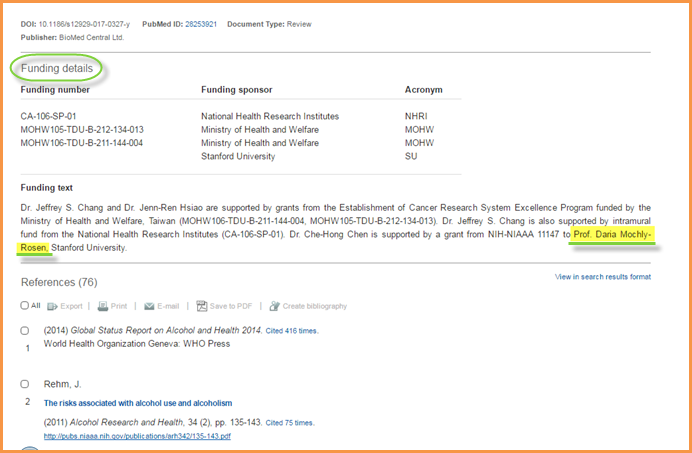New on Scopus: Link to datasets, search funding acknowledgements and find more CiteScore transparency
March has been an especially busy month for Scopus and to complete the month, we’ve introduced the following changes:
- The spine now opens as an overlay, rather than moving the body of the page
- The ability to link to research datasets
- The ability to find documents based on funding acknowledgement text
- More CiteScore transparency
To learn more details about these changes, follow along below. Click on images to expand.
A special note for librarians at SciVal institutions: You can now can use Scopus to create a Publication Set to export and analyze in SciVal. See more information below.
Research Dataset Linking
Research dataset links can now be found on the Scopus Document details page. Through collaboration with Data Literature Interlinking (DLI) service and Scholix, Scopus is able to link articles with datasets when available on the external data repository.
Here’s how to find research datasets on Scopus:
- If research datasets are available on the external data repository for an article, the Scopus Document details page will include a “Related Research Data” sidebar, located to the right of the article details.
- To access the dataset, click on the links provided
Look for more on this story in the next couple of weeks.
Funding acknowledgement text fully searchable
Scopus now includes the ability to search the entire acknowledgement section of an article, making it easier to find funded research. By using the “Fund-All” field in Advanced search, you can find documents that acknowledge a particular sponsor, lab, researcher, funding body, grant number, etc., to discover research funded or supported by a particular entity.
Here's how to search funding text on Scopus:
- On Scopus, go to “Advanced search”
- In the search query string text box, use the field code: Fund-All(enter term here)
- In the parentheses, enter the text you want to search for within the funding acknowledgement text.
- Click on Search
A more detailed tip and trick coming soon.
CiteScore Transparency
If you are a Scopus subscriber, you now have the ability to view and export both the list of documents used for the a serial title’s CiteScore denominator, and the list of citations used for the numerator.
Here’s an example using a title on Scopus:
If you open the Scopus Source details page for the title CA-A Cancer Journal for Clinicians, you’ll find it has a 2015 CiteScore value of 66.45. From the calculation, you can also see this is based on a numerator value of 8,904 (# of 2015 citation counts), and a dominator value of 134 (# of documents published from 2012-2014). This calculation is viewable to all, however, if you are a subscriber to Scopus, you can now also export the data behind the calculation. To do so, click on either the numerator and denominator. This opens a window displaying the data and additionally gives you the option to export the information into a CSV file.
A note for Librarians at SciVal institutions
Scopus and SciVal interoperability: creating and exporting a Publication Set
If you have access to both Scopus and SciVal, you can now create and export a Publication Set to analyze in SciVal. Use Scopus search functionality to create a uniquely defined Publication Set. Here’s how:
- First, search for documents (Tip: log in first to avoid being prompted later)
- Refine your search as desired and select the documents you want included. Note: If you select “All,” only the first 20,000 documents will be exported.
- From the “Export document settings” pop-up window, select “SciVal” and then click on “Export”
- If you’ve selected 5,000 or less documents, then the export to SciVal will be instant. SciVal will open and ask you to name you Publication Set.
- If you’ve selected more than 5,000 documents, processing may take up to 48 hours. Once the Publication Set is ready, you will be notified by e-mail.
We welcome your input. If you are interested in providing feedback to help improve Scopus, click here.













